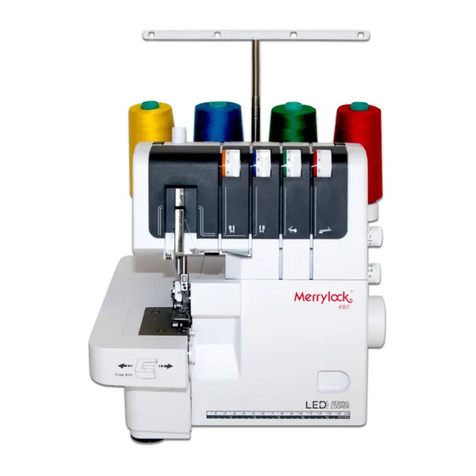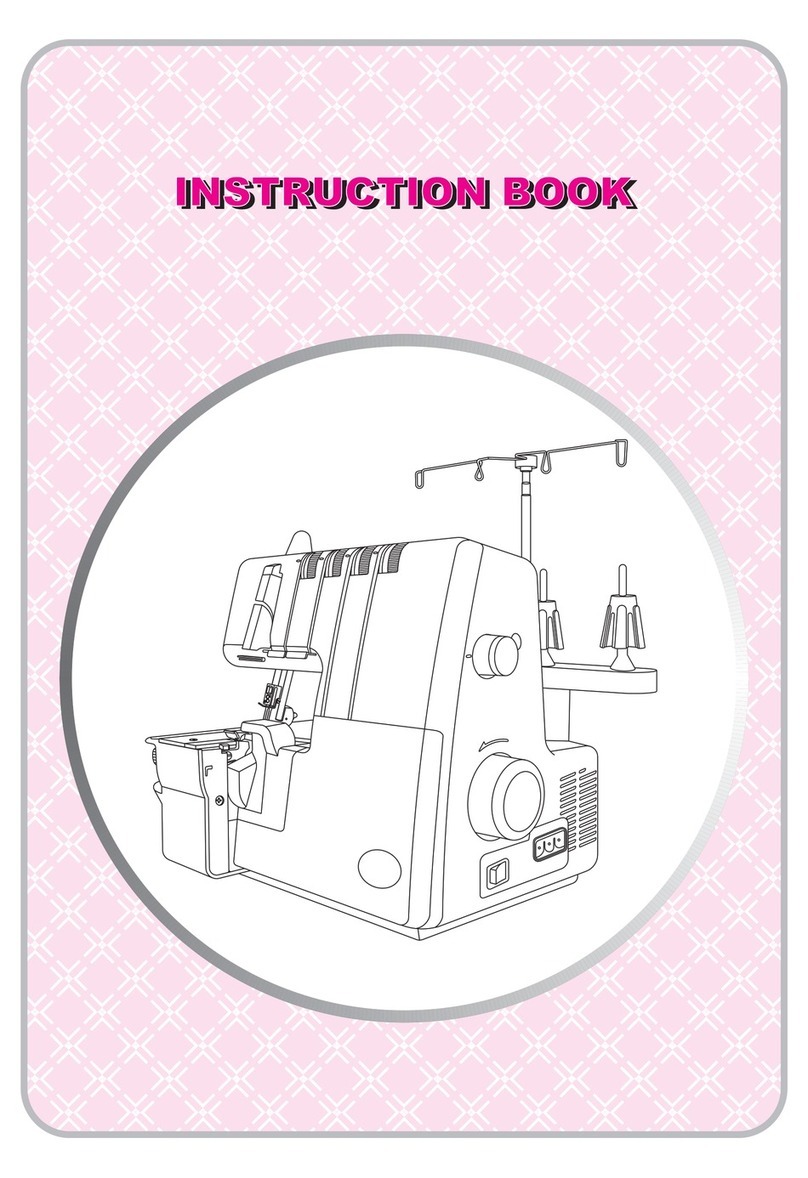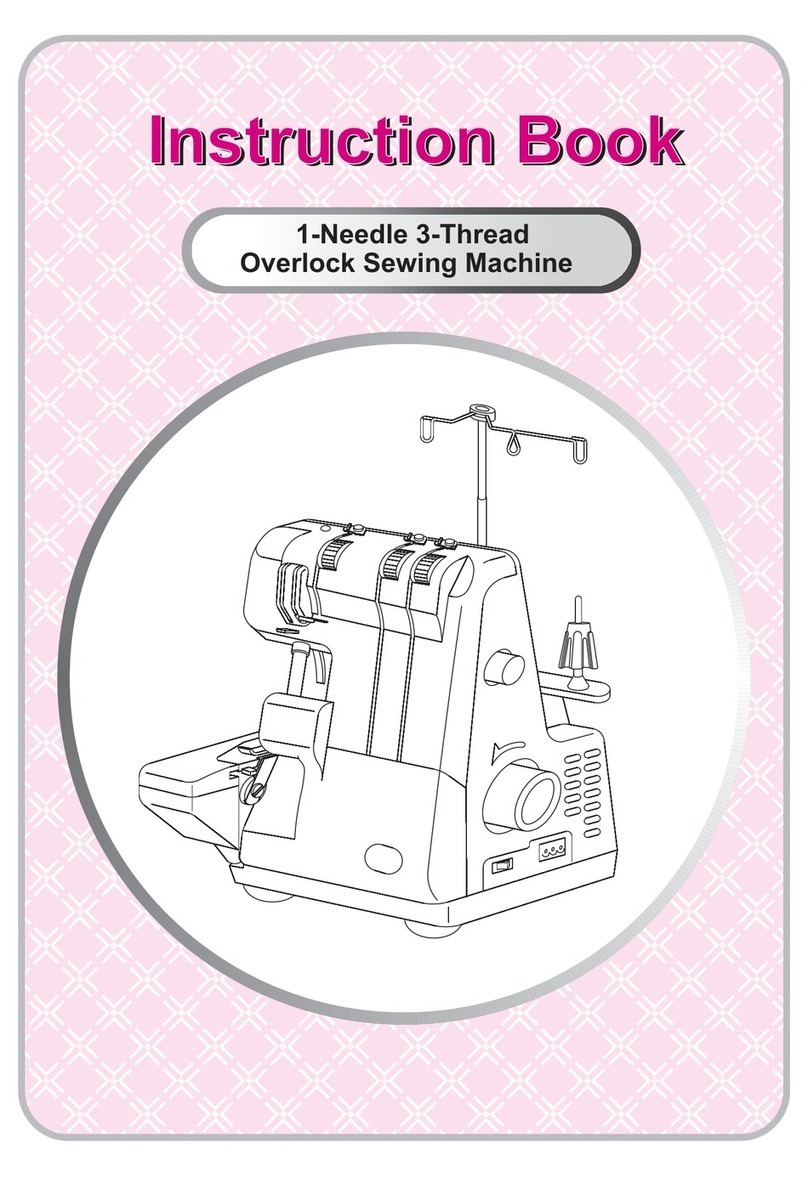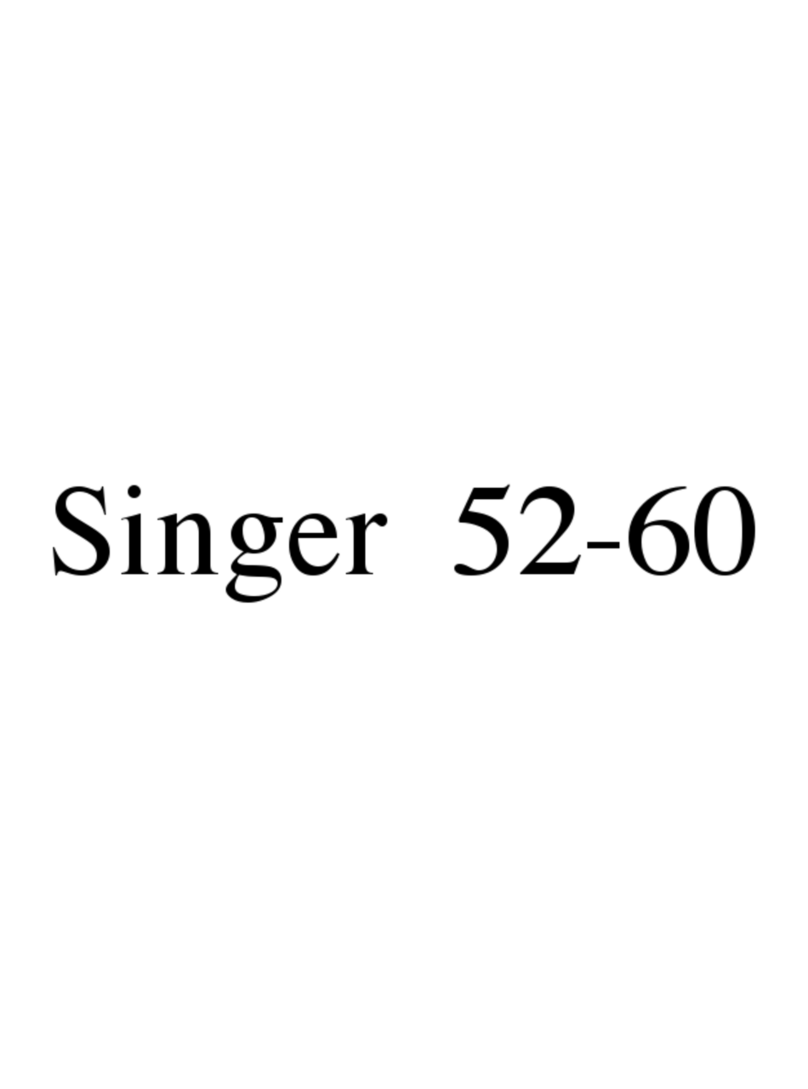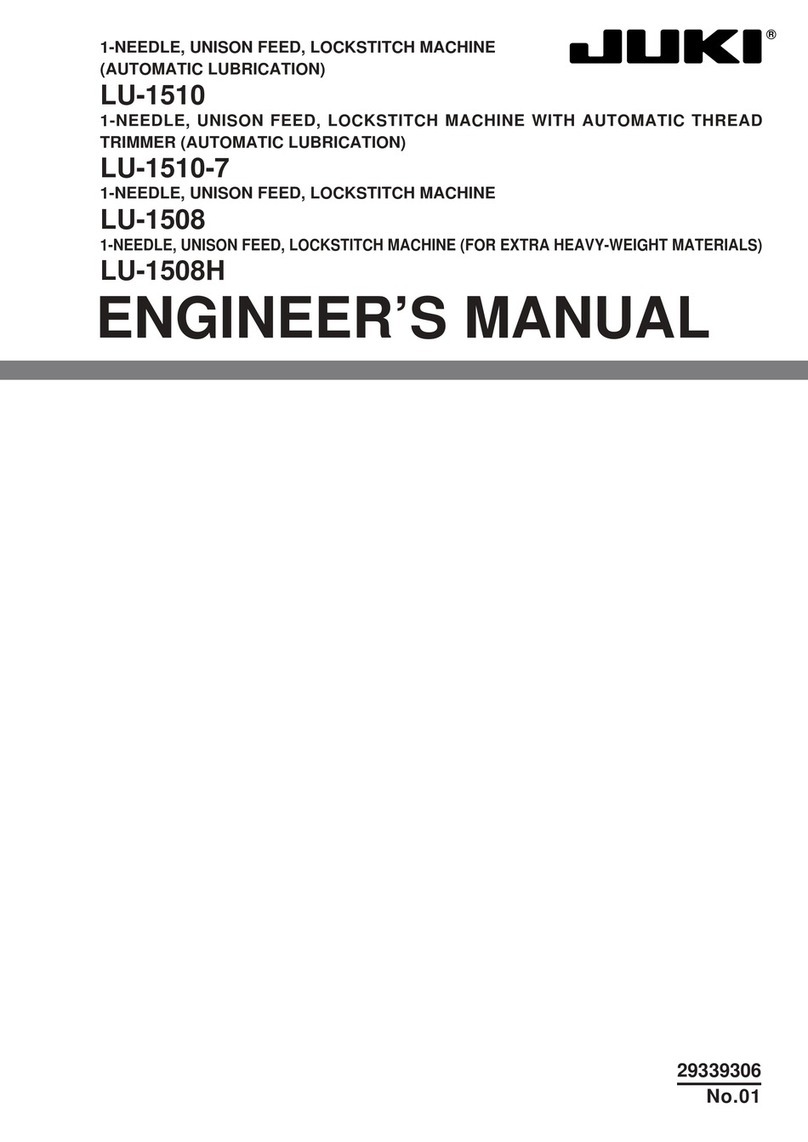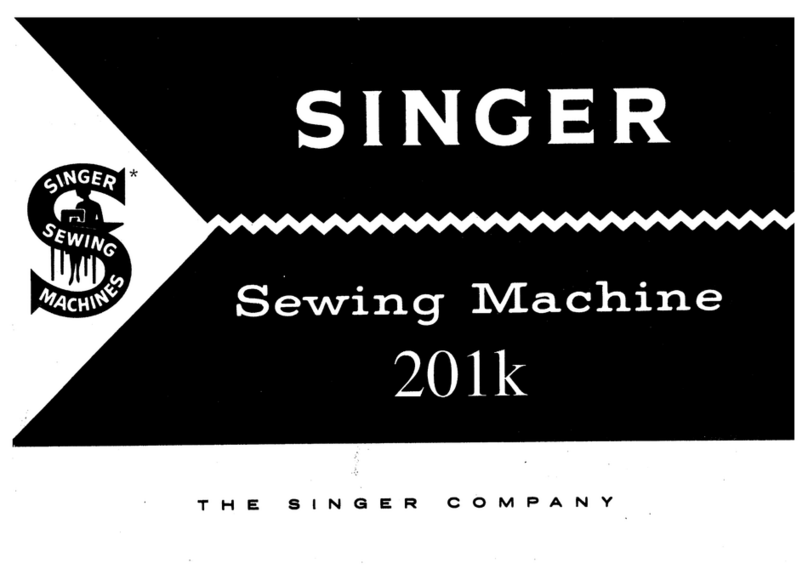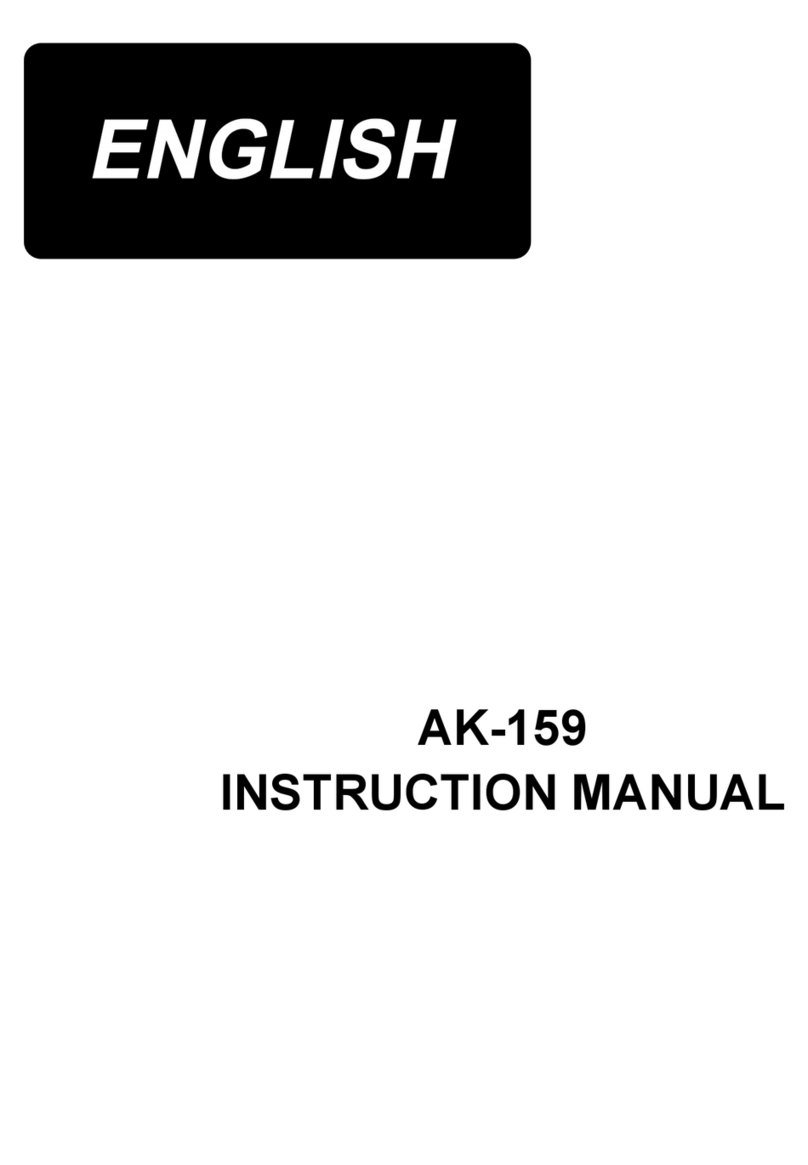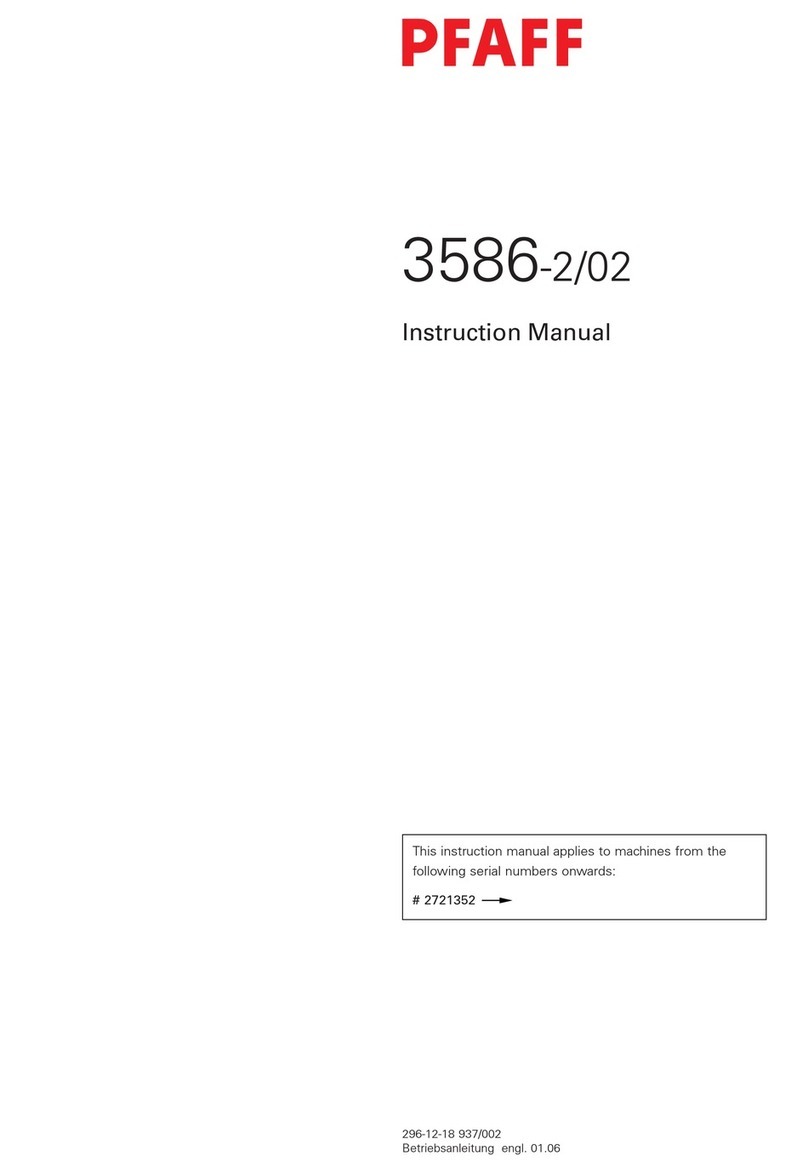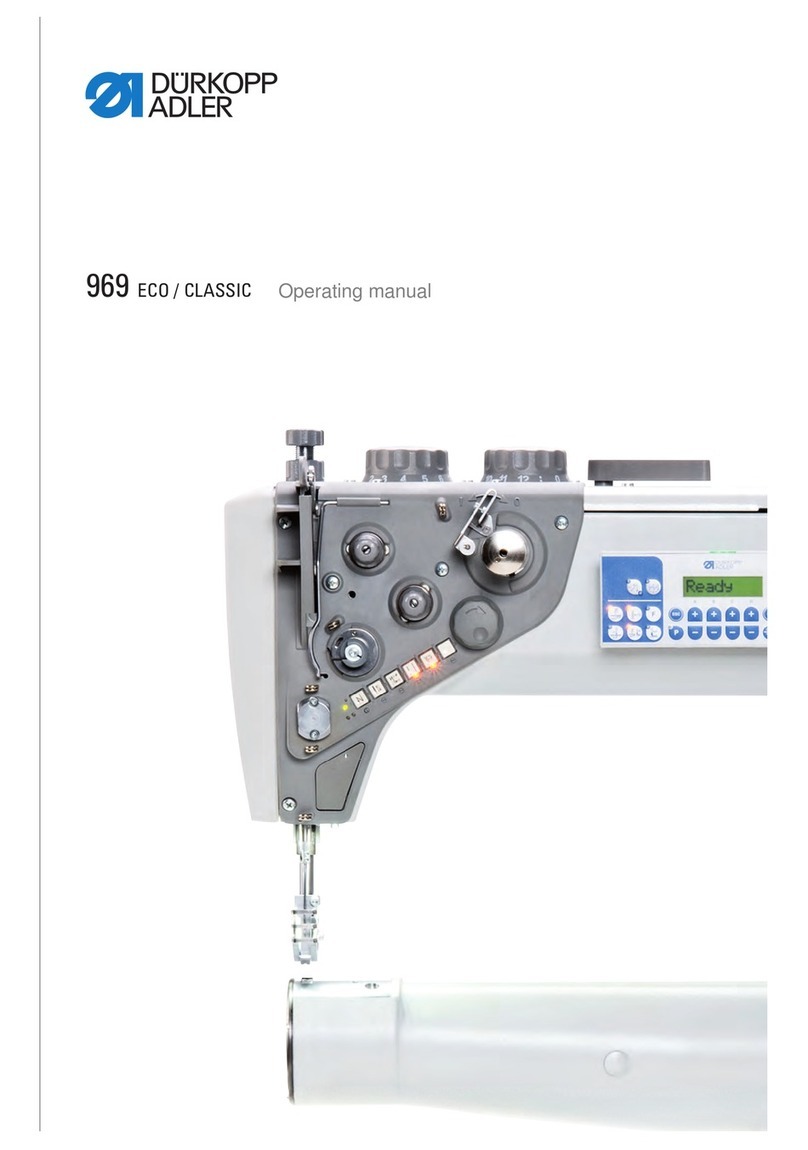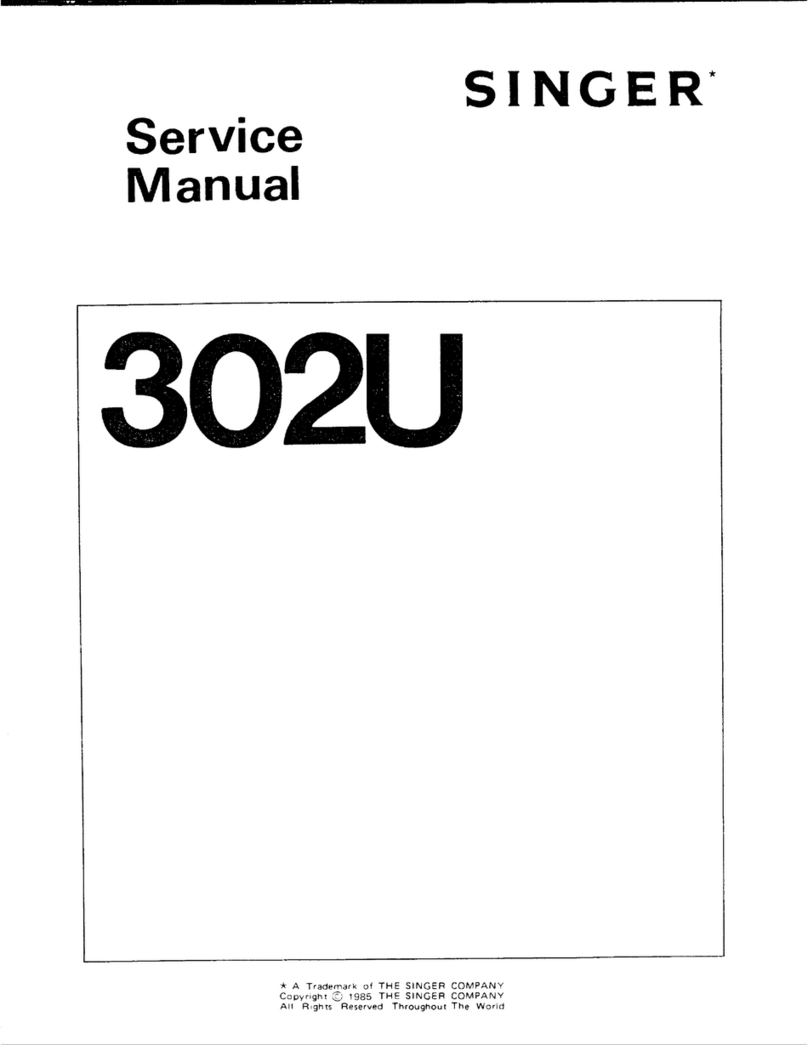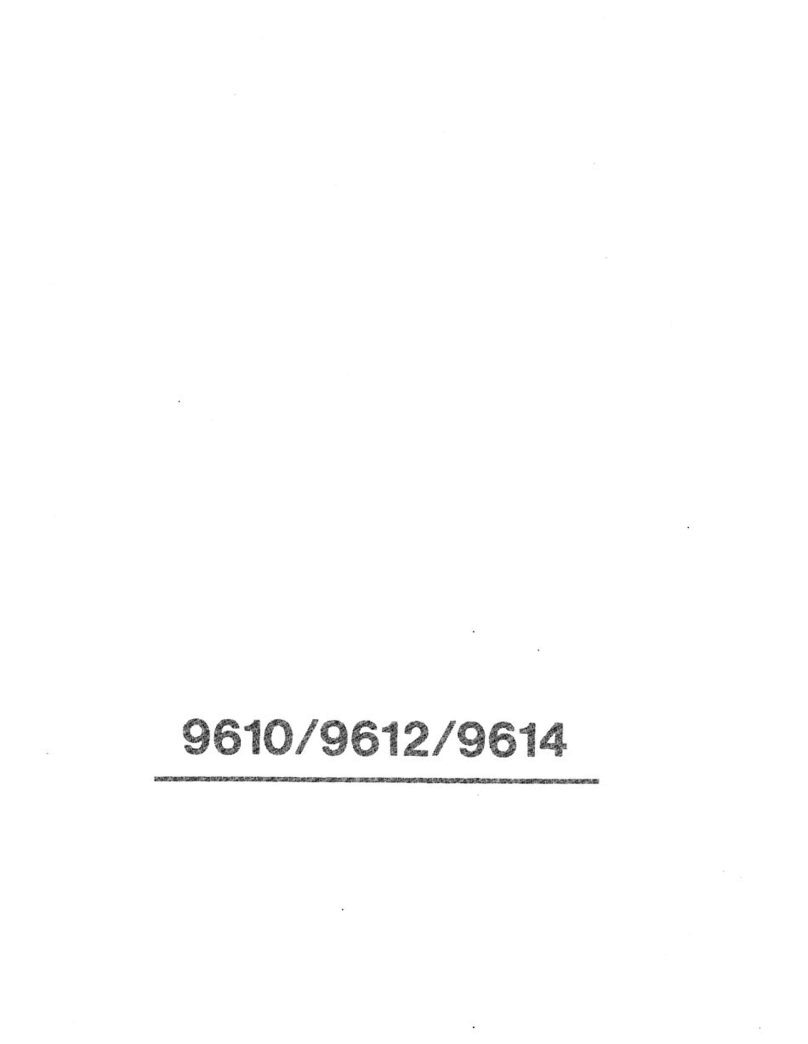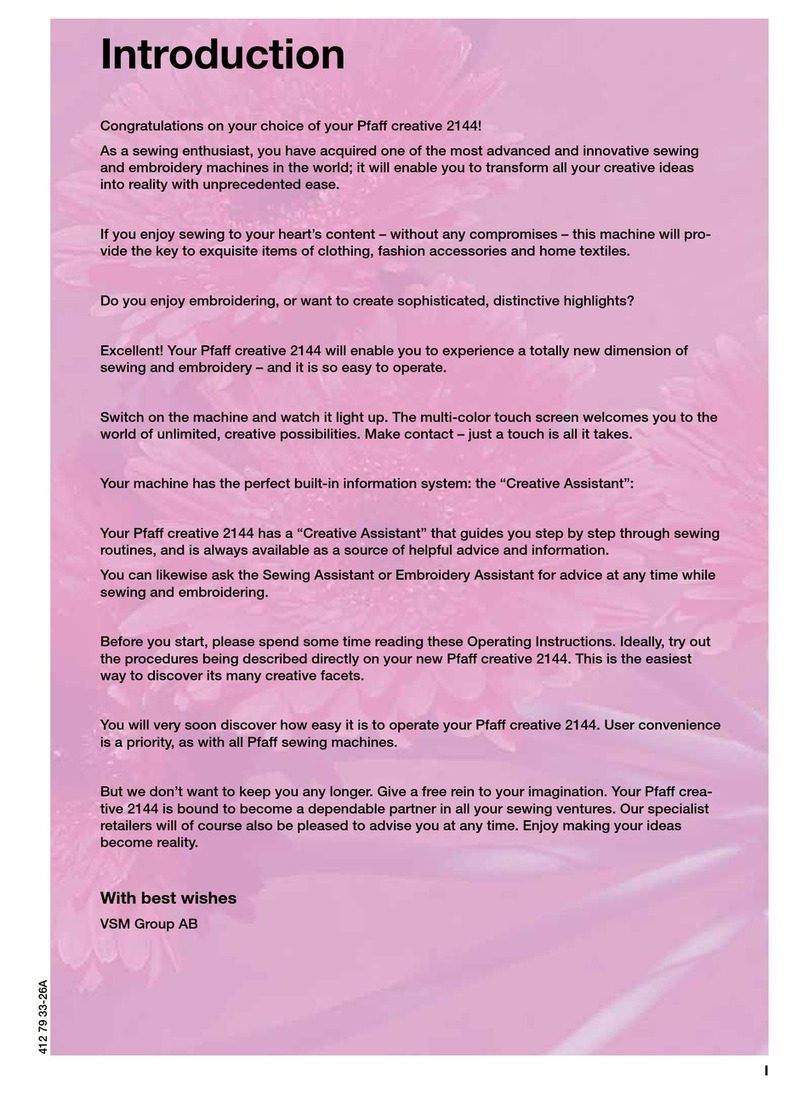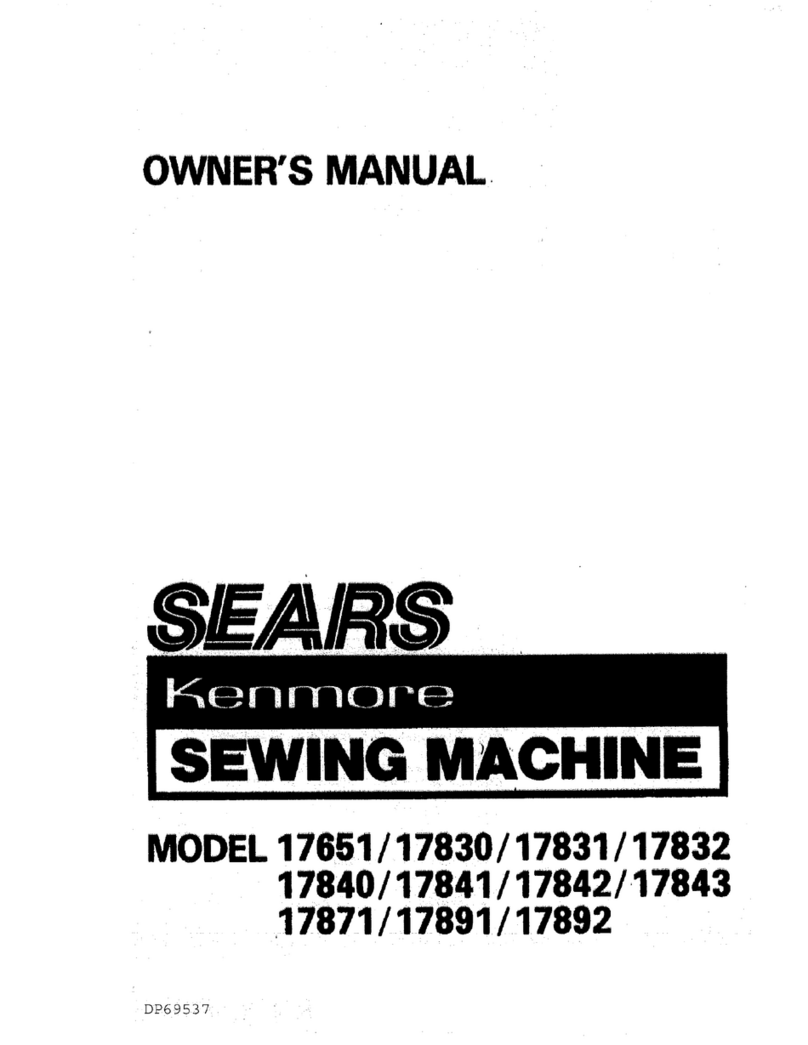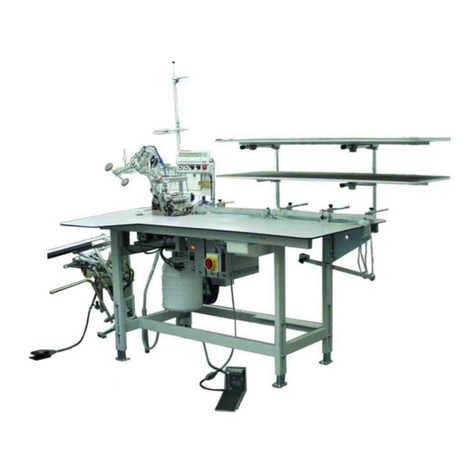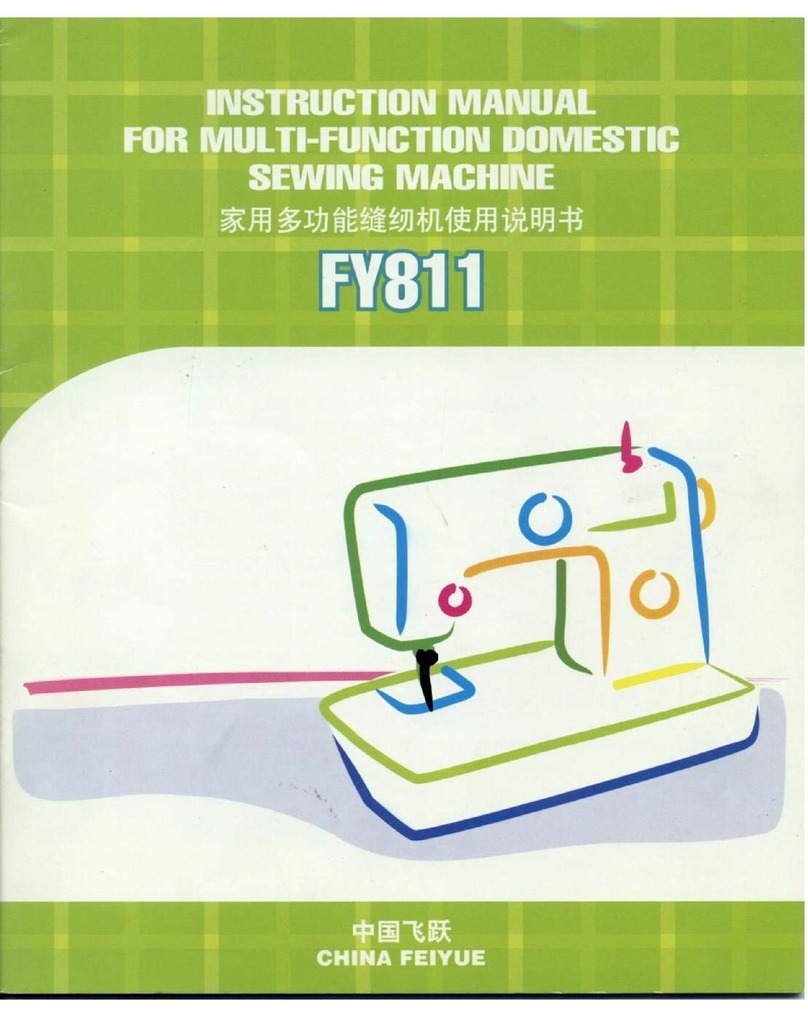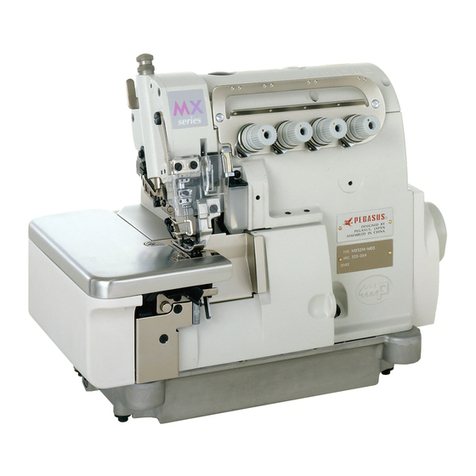Merrylock MK740DSA User manual


1
“IMPORTANT SAFETY INSTRUCTIONS“
“DANGER“___To reduce the risk of electric shock:
“WARNING“___
When using an electrical appliance, basic safety precautions should always be
followed, including the following: Read all instructions brfore using this overlock
sewing machine.
1. The appliance should never be left unattended when plugged in.
2. Always unplug this appliance from the electric outlet immediately after using and
before cleaning.
3. Always unplug before re-lamping. Replace bulb with same type rated
max. 110V~240V/15W.
1. Do not allow this appliance to be used as a toy. Close attention is necessary
when this appliance is used by or near children and infirm persons.
2. Use this appliance only for its intended use as described in this manual. Use only
attachments recommended by the manufacturer as contained in this manual.
3. Never operate this appliance if it has a damaged cord or plug, if it is not working
properly, if it has been dropped or damaged, or dropped into water. Return the
appliance to the nearest authorized dealer or service center for examination,
repair, electrical or mechanical adjustment.
4. Never operate the appliance with any air openings blocked. Keep ventilation
openings of the sewing machine and foot control free from the accumulation of
lint, dust, and loose cloth.
5. Keep fingers away from all moving parts. Special care is required around the
sewing machine needle and cutter.
6. Always use the proper stitch plate. The wrong plate can cause the needle to
break.
7. Do not use bent needles.
8. Do not pull or push fabric while stitching. It may deflect the needle causing it to
break.
9. Switch the sewing machine off “ O “ when making any adjustments in the needle
area, such as threading needle area changing needle, threading looper, or
changing presser foot and the like.
10. Always unplug the machine from the electrical outlet when removing covers,
when covers are opened to raise the upper cutter or thread the loopers, when
lubricating or when making any other user servicing adjustments mentioned in
the instruction manual.
11. Never drop or insert any abject into any opening.
12. Do not use outdoors.
13. Do not operate where aerosol (spray) products are being used or where oxygen
is being administered.
14. To disconnect, turn all controls to the off “ O “ position, then remove plug from
outlet.
15. Do not unplug by pulling on cord. To unplug, grasp the plug, not the cord.
16. If the power cord of this appliance is damaged, it must be replaced with a
special cord by your nearest authorized dealer or service center.
To reduce the risk of burns, fire, electric shock, or
injury to persons:

“This overlock sewing machine is intended for household use only.”
* Keep the instructions at a suitable place close to the machine and hand it over if
you give the machine to a third party.
* Use the machine only in dry locations.
* Never leave the machine unattended with children or elderly people due to they
may not be able to estimate the risk.
* Don’t let children play with the machine.
* This appliance is not intended for use by persons (including children) with reduced
physical, sensory or mental capabilities, or lack of experience and knowledge,
unless they have been given supervision or instruction concerning use of the
appliance by a person responsible for their safety.
* Children should be supervised to ensure that they do not play with the appliance.
* Always unplug the machine if you leave it unattended, to avoid injury by
expediently switch on the machine.
* Always unplug the machine if you carry out maintenance (oiling, cleaning).
* Don’t use the machine if it’s wet or in humid environment.
* Never pull at the cord, always unplug the machine by gripping the plug.
* Never place anything on the pedal.
* Never use the machine if the air vents are blocked keep the air vents of the
machine and the foot pedal free from dust, fusel and leftovers.
* The machine may only be used with foot pedal manufactured by Wakaho. Type
4C-316B for USA and Canada, 4C-316C/4C-326G/4C-345G for other countries.
* If the supply cord connected with foot pedal is damaged, it must be replaced by the
manufacturer or its service agent or a similarly qualified person, in order to avoid a
hazard.
2
“SAVE THESE INSTRUCTIONS“
17. If oil gets in eyes, immediately, rinse the oil out with water. If you swallow oil by
mistake, immediately consult a medical doctor.
20. To reduce risk of injury, switch off before servicing. Close looper cover before
operating.

Lors de l’utilisation de cette machine, les précautions élémentaires de sécurité
doivent être pris es. Lisez attentivement toutes les consignes de sécurité suivantes
avant de l’utiliser :
* Ne laissez pas la machine sans surveillance lorsqu’elle est sous tension.
Débranchez la immédiatement après l’utilisation et avant le nettoyage.
* Débranchez la machine avant de changer l’ampoule. Remplacer l’ampoule par une
autre de 15 Watts et du même type. Assurez vous d’avoir remis le cache après
avoir changé l’ampoule.
* Assurez vous que le voltage du moteur corresponde à celui de l’installation
électrique.
* Cette machine est conçue pour un usage familial tel que décrit dans cette notice
d’utilisation. Utilisez uniquement les accessoires conseillés dans cette notice.
* Pour débrancher la machine positionnez l’interrupteur sur « O » lorsque vous
effectuez des opérations telles que enfilage des aiguilles ou des boucleurs ,
changement de plaque à aiguille ou de pied presseur etc....
* Débranchez la machine lorsque vous retirez les carters , lubrifiez le mécanisme ou
lors de toute opération d’entretien décrite dans cette brochure.
* N’essayez pas de régler vous-même la courroie du moteur. Si un réglage s’avère
nécessaire, contactez votre Service Après Vente .
* Manipulez le rhéostat avec précaution et évitez de le faire tomber. Assurez-vous
que rien n’est posé dessus.
* Utilisez la plaque à aiguille adéquate. Une plaque non conforme pe ut casser
l’aiguille.
* N’utilisez pas d’aiguille tordue.
* Lors de la couture, éloignez vos doigts de toute pièce en mouvement et
particulièrement de l’aiguille.
* Ne tirez et ne poussez pas le tissu lors de la couture, cela pourrait casser l’aiguille.
* Pour l’entretien des machines à double isolation, n’utilisez que des pièces de
rechange identique . Voir les instructions pour le service après-vente des appareils
à double - isolation.
* Ne jamais utiliser la machine si le cordon ou la prise électrique sont endommagés,
si elle est tombée ou abîmée, si elle a été exposée à l’eau. Contactez votre
Service Après Vente pour tout examen , réglage ou réparation.
* N’utilisez pas la machine si les aérations ou le rhéostat sont obstrués par la
poussière, la bourre de fil ou de tissu.
* N’insérez ou ne faîtes pas tomber d’objets dans les ouvertures de la machine.
* Pour réduire le risque de blessures, éteindre l'interrupteur avant l'entretien. Fermer
le couvercle boucleur avant exploitation.
CONSIGNES DE SECURITE
3
DANGER - Pour reduire le risque de décharges électriques :
AVERTISSEMENT - Pour réduire le risque de brûlures, de feu, de
décharges électriques ou de blessures Aux personnes :

4
TABLE OF CONTENTS
1. DETAILS OF THE MACHINE......................
2. OPTIONALPRESSER FEET......................
3. .........................................ACCESSORIES
4. NEEDLE INFORMATION...........................
5. .........PREPARATION PRIOR TO SEWING
6. REPARING THE MACHINE.....................P
(1) ..................Assembling the thread stand
(2) .........................................Thread cones
(3) .......................................Waste collector
7. .............HOWTO OPEN LOOPER COVER
8. HOW TO REMOVEAND INSERT
NEEDLES..................................................
(1) Needle position......................................
2) To remove needle (s)..............................(
.............................9. PRESSER FOOT LIFER
10. OPTIONALACCESSORIES....................
11. STANDARD OVERLOCK AND
ROLLED HEM STITCHING......................
12. THREADING THE MACHINE...................
(1) Threading the upper looper (Green)......
( ...........2) Threading the lower looper (Red)
(3) Threading the right needle (Blue)
(B on needle clamp)...............................
(4) Threading the threading the left needle
(Yellow) (A on needle clamp).................
13. HOW TO CHANGE THREADS:
TIE ON METHOD.....................................
14 TITCH LENGTH......................................S
............15. STITCH WIDTHADJUSTMENTS
idth adjustment by changing(1) W
needle position.....................................
(2) Width adjustment with
...................................adjustment knob
5
7
8
8
8
9
9
9
9
10
10
10
10
11
11
12
12
13
14
16
17
19
19
20
20
20
16. SELECTION OF STITCHES....................
17. HANDY REFERENCE CHART................
18. SEWING......CHAINING OFF AND TEST
..............................19. FLATLOCK SEWING
.........................(1) Standard flatlock stitch
.....................(2) Ornamental flatlock stitch
........................................(3) Ladder stitch
20. Differential feed........................................
(1) Stretching effect...................................
(2) Pushing effect......................................
(3) Gathering.............................................
21. SUGGESTED TENSION SETTING.........
(1) 4-Thread overlock................................
(2) 3-Thread overlock................................
(3) 3-Thread flatlock.................................
(4) ..........................3-Thread rolled edge
22. MACHINE MAINTENANCE.....................
(1) Cleaning the machine...........................
(2) Oiling the machine...............................
eplacing the movable upper cutter......(3) R
(4) How to exchange light bulb...................
...............23. TROUBLESHOOTING CHART
24. RELATIONSHIP BETWEEN CLOTH,
THREADAND NEEDLE..........................
25. SPECIFICATION.....................................
21
21
23
24
24
24
24
25
25
25
25
26
26
27
28
29
29
29
30
30
31
32
33
34

5
1 Lower looper tension dial.
2. Upper looper tension dial
3. Right needle tension dial
4. Left needle tension dial
5. Thread take up cover
6. Cloth plate
7. Looper cover
8. Lower looper tension dial
9. Open thread guide
10. Retractable support rod
11. Thread guide plate
12. Spool holder pin
13. Anti-vibration cone
14. Thread stand
15. Stitch length dial
16. Handwheel
17. Machine socket
18. Power / light switch
1. DETAILS OF THE MACHINE
910
12
13
14
15
16
17
18
7
6
5
1
2
3
4
8
11

6
19. Knife guard
20. Presser foot
21. Cloth plate
22. Stitch plate
23. Handle
24. Bulb cover
25. Presser foot lifter
26. Differential feed dial
27. Accessory box
28. Cutting width dial
23
24
19
20
21
22
25
26
27
28

7
1) Elastic Foot
*This foot is used for attaching elastic tape to the
garment and the amount of contraction of the elastic
tape can be adjusted as required.
2) Blind Hem Foot
* This foot is for sewing cuffs on knit fabrics, skirt
and trouser seams where seam should not be
visible.
3) Shirring Foot
* This foot is most suited for gathering when sewing
tiered skirts, yokes, cuffs and frills on skirts, etc.
This foot is also suited for sewing two fabrics*
together and gathering the bottom fabric in one
operation.
4) Pearl/Sequin Foot
* This foot is used for sewing on beads, etc.
5) Piping/ Cording Foot
* This sewing foot is suited for sewing welting
between two plies of fabric.
6) Taping Foot
* This sewing foot is suited for sewing on tapes, etc.
2. OPTIONAL PRESSER FEET

8
ON
OFF
3. ACCESSORIES
1. Screwdriver
2. Tweezers
3. Oiler
4. Cleaning brush
5. Set of needles ELx705
6. Net
7. Spool caps
8. Waste collector
9. Hexagon wrench
10. Upper knife
4. NEEDLE INFORMATION
* This overlock uses a flat shank industrial needle
that eliminates the possibility of inserting the needle
backwards.
* Do not attempt to use a standard household sewing
machine needle of any size or type in this overlock.
* Needle ELX705 size 14/90 is furnished with the
machine.
* Only use Needle ELX705 size 14/90 and 12/80 as
supplied in the accessory case.
5. PREPARATION PRIOR TO SEWING
* Connect the controller/electric plug to the machine
receptacle.
* Plug power line into electric outlet.
* Power Switch: Push " l " mark side to turn "ON"
Push "O" mark side to turn "OFF"
* To run the machine and control the speed, press
the controller.
* The harder you press, the faster the machine will
sew.
* To stop the machine from sewing, remove your foot
from the controller.
ELx705
Overlock needle
3
12 4
58
9
67
10

9
(1) t sAssembling the hread tand
Raise the support rod fully, turning slightly until the
positioning catches engage.
(2) cThread ones
The anti-vibration cone should be used with the
wider edge to the bottom on the spool holder pin
when sewing with cones. When using household
spools remove the anti-vibration cones.
Place spool on spool holder pins and push the
spool caps on. If threads slip and get twisted,
cover the spools with the nets supplied in the
accessory box.
(3) cWaste ollector
Fabric waste will be collected as you sew.
Push the waste collector under the front of the
machine and slightly to the left towards the cloth
plate cover.
Anti-spill net
Spool cap
Press in
Thread spool
6. REPARING THE MACHINEP

10
7. HOW TO OPEN LOOPER COVER
* Push the cover to the right as far as it will go.
* Pull cover down toward you.
8. HOW TO REMOVE AND INSERT
NEEDLES
(1) Needle position
* With this machines, two needles can be inserted to
the needle clamp as shown in the drawing.
* The Instruction Book refers to different needle
positions by illustrating the needle clamp at right.
Note: When both the left and right overlock needles
are inserted, the left needle will be slightly
higher than the right.
(2) To remove needle (s)
* Turn the hand wheel toward you until the needles
are at their highest position.
Place a thick piece of fabric [such as felt] under the*
presser foot. Lower the needles halfway into the
fabric.
Loosen, but do not remove the needle set screws*
with the small allen screwdriver. Hold the needles
with your fingers and raise the needle bar.
The needles will remain in the fabric.
A. Overlock left needle
B. Overlock right needle
Attention:
After removing the specific needle which is not
currently to be used for sewing, remember to fasten
the set screw in the screw hole of the needle clamp
and to just fasten tight into the hole.
Please do not over-tighten the screw into the hole or
the needle clamp will be damaged.
(3) To insert needles (s)
* Hold the needle with the flat surface to the back.
Insert the needle into the needle socket as far as it*
will go.
When inserting a needle, if you first lower it down*
into the hole in the throat plate it will line up with
the needle socket. Then direct it upwards
Note: When inserting needles into the A or B sockets
it is necessary to loosen both A & B Allen
Screws. After inserting the needles equally
tighten both screws.
This machine uses ELX705 needles. Do not use
Standard Household Needles.
Overlock left needle
Overlock right needle
Flat surface to the rear
To loosen
To tighten
Be sure to disconnect the machine from the
electric outlet before removing needle(s).

11
To raise the presser foot, raise the lever on the rear of
the machine until it engages.
10. OPTIONAL ACCESSORIES
* The following optional presser feet specially
prepared for this machine are available at
extra-charge.
Note: Do not use presser foot made for other
machines.
Use of such presser foot may result in
interference with the needle and knife and can
be hazardous.
* The snap-on type presser foot of this machine
permits easy removal and replacement.
Snap-on type presser foot
Removal
* Raise presser foot and raise needle bar to its highest
position.
* Press red colored lever (A) located on back of clamp
under the presser foot shank, raise presser bar lifter
to its High Lift position and while holding the presser
bar lifter in this position, remove the presser foot
plate.
Replacement
* Place presser foot plate on throat plate under presser
foot shank so that hinge pin (C) will fit inslot (B) of
the shank. Then lower presser bar lifter.
* If presser foot plate can not be placed under presser
foot shank easily, raise presser bar lifter to its High
Lift position and while holding it in this position,
place presser foot plate under presser foot shank.
Then lower presser bar lifter.
* Raise presser bar lifter and make sure the presser
foot plate is properly attached to the presser foot
shank.
9. PRESSER FOOT LIFER
Be sure to disconnect the power line plug or
turn off the power switch when changing the
presser foot.
B
C
A

12
lever
lever
To sew standard overlock
* Set seam width finger knob to N to move seam
width finger to standard overlock sewing position.
Note: Be sure to push seam width finger knob as
far as it will go in the direction of setting N.
To sew rolled hem
* Set seam width finger knob to R to retract the seam
width finger and set it for rolled hem.
Note: Be sure to push seam width finger knob as far
as it will go in the direction of setting R.
12. THREADING THE MACHINE
(1) Threading diagram: Overlock
*Disconnect machine from electricity supply.
Support rod with thread guide must be fully*
raised.
Open the looper cover and the cloth plate cover.*
Turn the handwheel towards you until needles*
are fully raised.
Thread the machine in the correct sequence.*
Overlock(2) Tension color code:
1. Upper looper thread............................Green
2. Lower looper thread............................Red
3. Right stitch looper thread....................Blue
4. Left needle thread.............................. Yellow
11. STANDARD OVERLOCK AND
ROLLED HEM STITCHING
4
4 3 1 2
2
31

2
4
3
13
Be sure to turn off power switch.
To thread the machine correctly
(1) Threading the (Green)upper looper
* Thread the upper looper as indicated 1~7.
* Raise Presser foot to release tension discs.
* Pass thread from back to the front through the
thread guide 1.
* Thread the top cover thread guide by pulling the
thread towards the left until it slips under guide.
Then pull thread along the right side of button as
illustrated.
* While holding thread with fingers, pass it between
the tension discs and pull thread down to make
certain it is properly located in between the tension
discs 3.
2
3
4
5
6
7
1
1
2
2
3
3

10cm
(4")
14
* Thread the looper area of the machine following the
green color coded thread guides (4~7).
Thread the hole in the upper looper from front to*
back 7. Note: Make sure thread passes behind
lower looper.
Note: Use tweezers provided in the accessory
case to aid in threading the looper.
* Pull about 10cm(4 inches) of thread through the
looper and place to the back of the throat plate.
(2) Threading the (Red)lower looper
*Thread the lower looper as indicated 1~9.
* Raise Presser foot to release Tension discs.
* Pass thread from back to the front through the
thread guide 1.
* Thread the top cover thread guide by pulling
the thread towards the left until it slips under
guide. Then pull thread along the right side of
button as illustrated.
1
2
2
7
6
5
4
1
2
3
4
5
6
7
8
9

2
4
3
15
* While holding thread with finger, pass it between
the tension discs and pull thread down to make
certain it is properly located in between the
tension discs 3.
* Turn the hand wheel toward you until the lower
looper extends out 5~10mm from the throat plate
edge.
* Thread the looper area of the machine following
the red color coded thread guides 3~8.
Note: Use tweezers provided in the accessory
case to aid in threading the looper.
* Place the thread with the point of the tweezers
slightly from left and to the right of threading guide 3.
* Thread the looper eye (A) from front to back.
Pull about 10cm (4 inches) of thread.
Position thread into V cutout (B) on threader.
Firmly hold thread tail with left hand and pull
Threader lever (C) up into place (D).
33
4
4
5
6
7
7
8
9
5
6
7
8
9

2
4
3
16
(3) Threading the (Blue)right needle
(B on needle clamp)
* Thread the right needle as indicated 1~9.
* Raise Presser foot to release Tension discs.
* Pass thread from back to the front through the
thread guide 1.
Thread the top cover thread guide by pulling the*
thread towards the left until it slips under guide.
Then pull thread along the right side of button as
illustrated.
While holding thread with finger, pass it between*
the tension discs and pull thread down to make
certain it is properly located in between the
tension discs 3.
3
1
1
2
2
2
3
45
6
7
8
9
3

17
* Continue to thread points 4~9.
Note: Slip thread into the rear slot on the thread guide 5 and
bottom slot of take-up lever cover 6. Then slip thread
into the right slot on the thread guide 7.
* Before threading eye of needle, slip thread behind thread
guide located on the bottom of the needle clamp.
*Thread the eye of the right needle 9.
Note: Use of tweezers in the accessory case will
make needle eye threading easy.
* The position of the thread must be behind the thread
guide.
* Draw about 10cm(4 inches) of thread through
needle eye towards the rear of machine.
* Place the thread to the back, under the presser
foot.
(4) Threading the threading the left needle
(Yellow) (A on needle clamp)
* Thread the left needle as indicated 1~9.
* Raise Presser foot to release Tension discs.
* Pass thread from back to the front through the
thread guide 1.
3
1
2
4
4
5
5
6
6
7
7
8
9
8
9
9
1

2
4
3
18
* Thread the top cover threadguide by pulling the
thread towards the left until it slips under guide.
Then pull thread along the right side of button as
illustrated.
* While holding thread with fingers, pass it between
the tension discs and pull thread down to make
certain it is properly located in between the
tension discs 3.
* Continue to thread points 4~9.
Note: Slip thread into the middle slot of the thread
guide 5 and into the lower slot of take-up lever
cover 6.
Then continue by slipping thread into the middle
slot of the thread guides 7 and 8.
Note: For 4 thread overlock left needle: Use neddle A.
Before threading eye of needle, slip thread behind
thread guide located on the bottom of the needle
clamp.
Before threading eye of needle, make sure thread
is located on the bottom ofin front of thread guide
the needle clamp.
* Thread the eye of the left needle 9.
Note: Use of tweezers in the accessory case will
make needle eye threading easy.
* The position of the thread must be behind the the
thread guide.
* Draw about 10cm (4 inches) of thread through
needle eye to hang free.
* Place the thread to the back, under the presser foot.
2
2
3
3
4
5
6
7
8
9
9

19
* To change thread type or color, clip thread near
the spool.
* Place new thread on stand.
* Tie new thread and old thread ends together with a
square knot. Clip thread tails to 2~3cm (1 inch)
length. If clipped too short, threads may come
untied.
* Firmly pull both thread to test knot security.
* Raise Presser foot to release Tension discs.
* Pull the threads through the machine one at a time.
* If threads do not pull easily, check for tangles on
thread guides or looping under thread stand.
* When pulling thread through the needles, STOP
when the knot is in front of the needle.
* Cut the thread, and insert it through the needle.
14 TITCH LENGTH. S
* The stitch length can be adjusted
from 1 to 4 mm.
Higher number longer stitch lower*=,
number = shorter stitch.
* Basic stitch length N=.
13. HOW TO CHANGE THREADS:
TIE ON METHOD
Table of contents
Other Merrylock Sewing Machine manuals
